Driving Test Questions
1/564
There's no tags or description
Looks like no tags are added yet.
Name | Mastery | Learn | Test | Matching | Spaced |
|---|
No study sessions yet.
565 Terms
hat should you do if your vehicle has a puncture on a motorway?
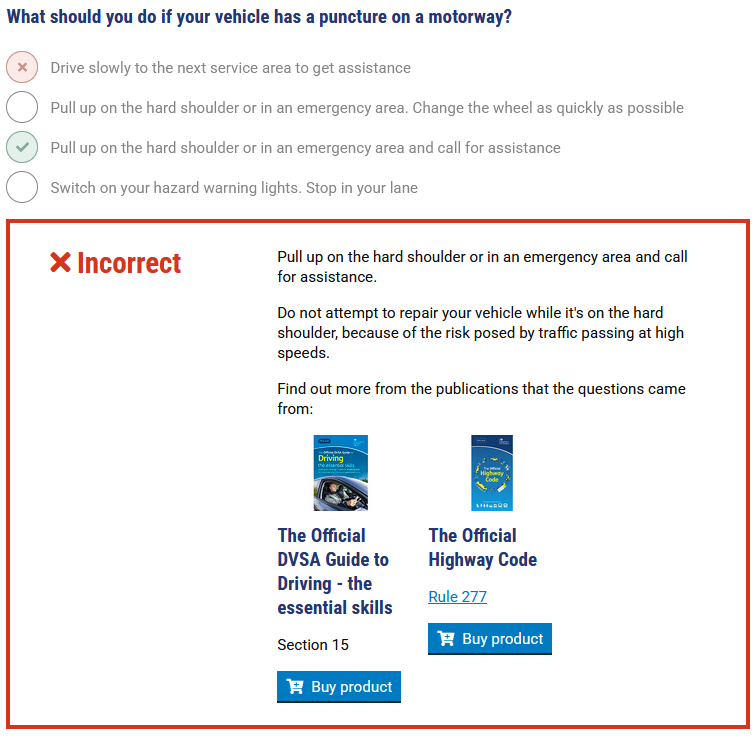
At an incident, how could you help a small child who's not breathing?

You're waiting at a pelican crossing. What does it mean when the red light changes to flashing amber?
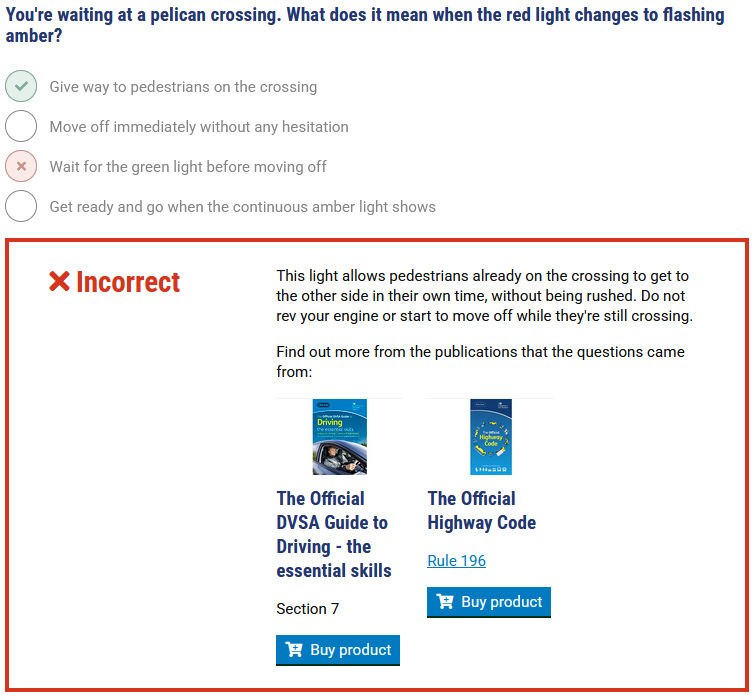
What would you expect to find at a contraflow system on a motorway?
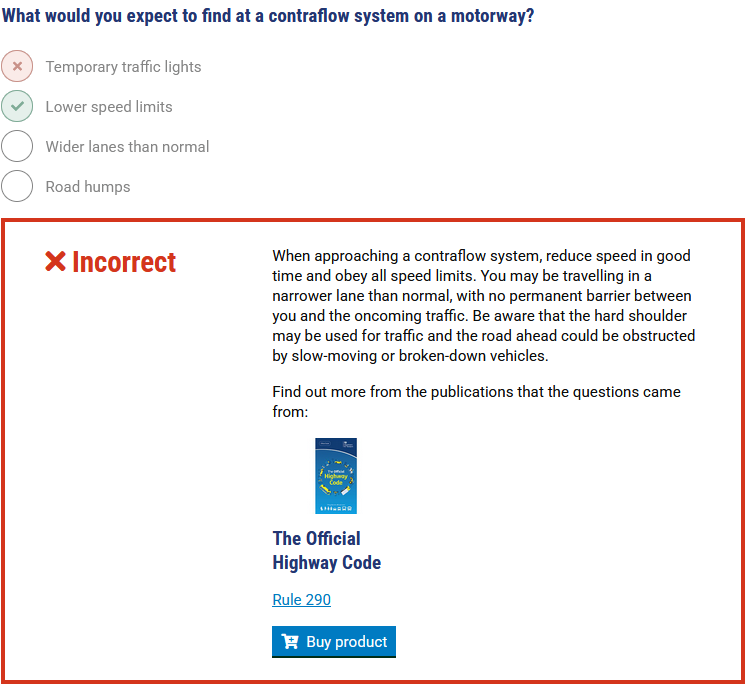
What hazard should you be especially aware of if you're turning left into a side road?
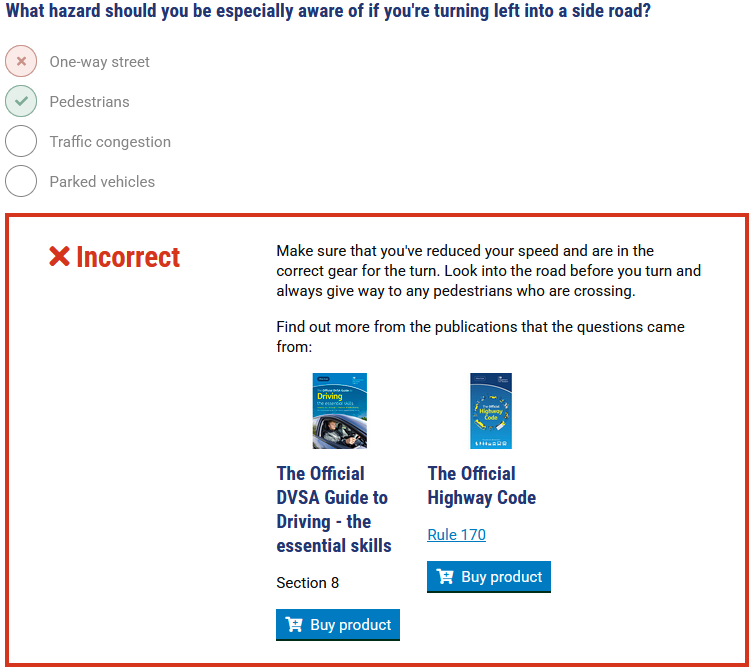
What will happen if your car's wheels are unbalanced?
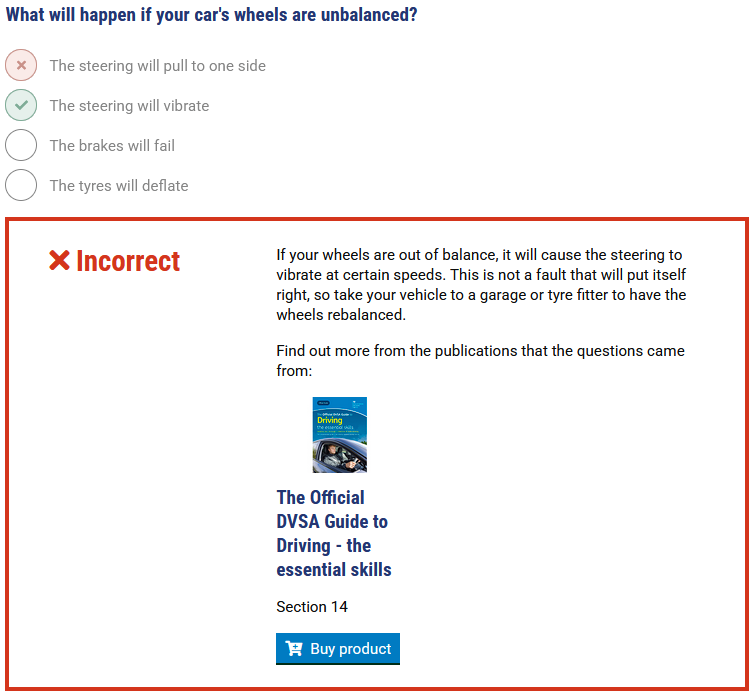

Why must you take great care when emerging from this junction?
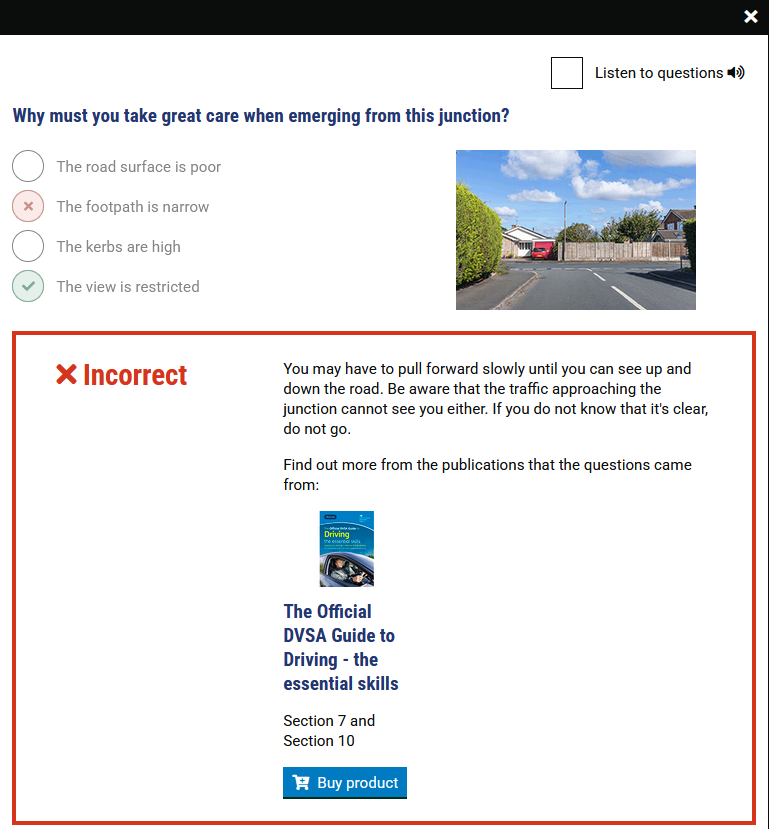
What color are the reflective studs along the left hand edge of the motorway?
Answer: C. Red.
Explanation: Reflective studs are used to help you in poor visibility. Different colors are used so that you'll know which lane you're in. These are red on the left hand edge of the carriageway, white between lanes, amber on the right hand edge of the carriageway, green between the carriageway and slip roads.
You're driving at night. What should you do if you're dazzled by headlights coming towards you?
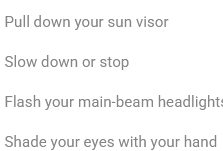
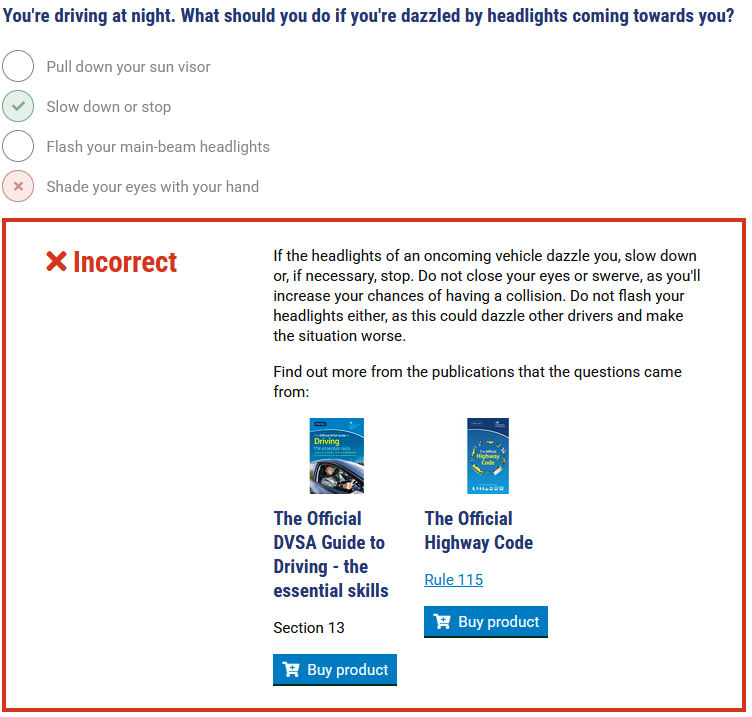
You arrive at the scene of a motorcycle crash. No other vehicle is involved. The rider is unconscious and lying in the middle of the road. What's the first thing you should do at the scene?
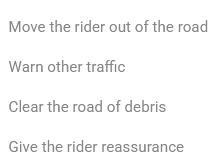

When should you flash your headlights at other road users?
Answer: A. When letting them know that you're there,
Explanation: you should only flash your headlights to warn others of your presence. Don't use them to greet others, show impatience, or give priority to other road users because they could misunderstand your signal.

A steady amber light
You're parked on the road at night. When must you use parking lights?
- Answer: A. when the speed limit exceeds 30 mph.
- Explanation: When parking at night, park in the direction of the traffic. This will enable other road users to see the reflectors on the rear of your vehicle. Use your parking lights if the speed limit is over 30 mph.
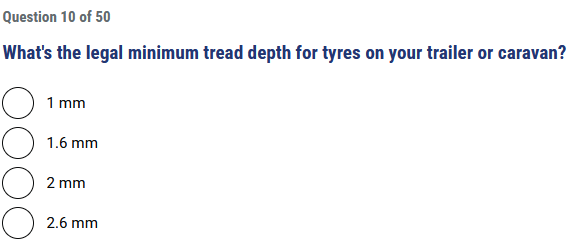
1.6mm
How can you tell what type of blind someone is?
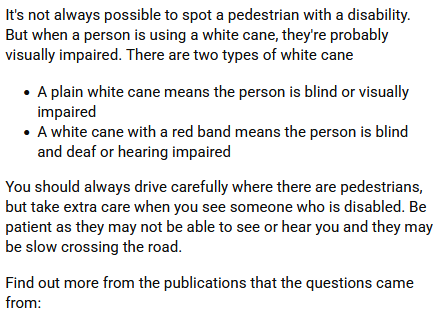
What should you do immediately after joining a motorway?
- Answer: C. Stay in the left hand lane
- Explanation: when you've just joined a motor. motorway. Stay in the left-hand lane long enough to get used to the higher speeds of motorway traffic before considering overtaking.
What should you do if you see a large box fall from a lorry onto the motorway?
- Answer: B. Go to the next emergency telephone and report report the hazard.
- Explanation: Lori drivers can be unaware of objects falling from their vehicles. If you see something fall onto a motorway, look to see if the driver pulls over. If they don't stop, don't attempt to retrieve the object yourself. Pull onto the hard shoulder near an emergency telephone and report the hazard.
You want to turn right at a box junction. What should you do if there's oncoming traffic?

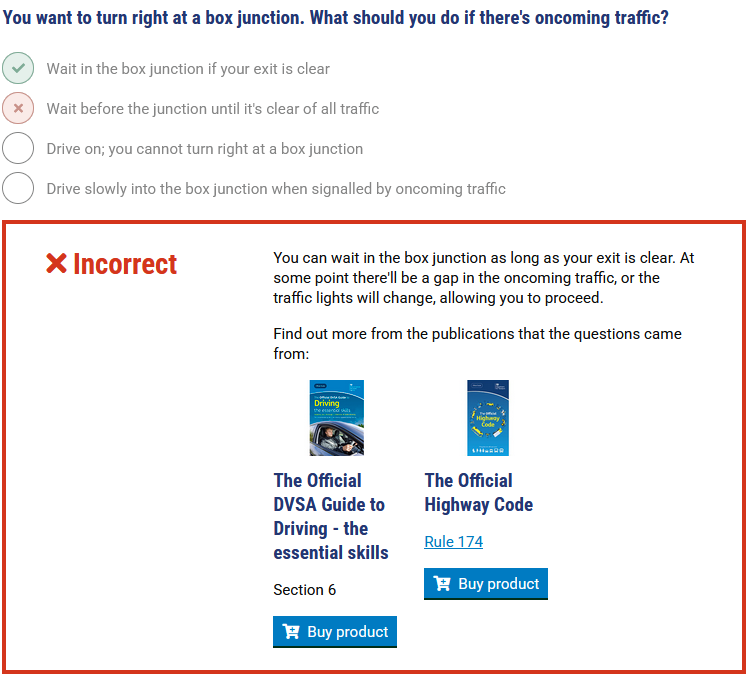
You're the first person to arrive at an incident where people are badly injured. You've switched on your hazard warning lights and checked all engines are stopped. What else should you do?
- Answer: A. Make sure that an ambulance has been called.
- Explanation: If you're the first to arrive at a crash scene, the first concerns are the risk of further collision and fire. Ensuring that vehicle engines are switched off will reduce the risk of fire. Use hazard warning lights so that other traffic knows there's a need for caution. Make sure the emergency services are contacted. Don't assume it's already been done.
You're planning to tow a caravan. What will help the handling of the combination?
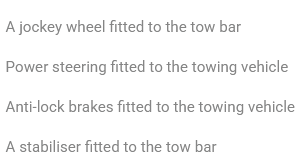

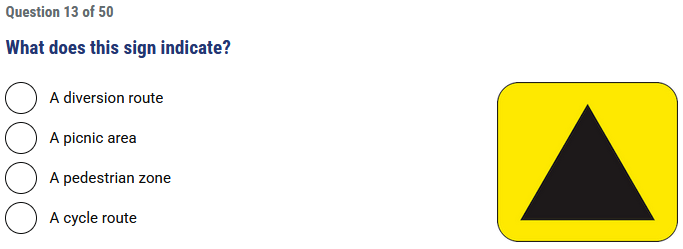
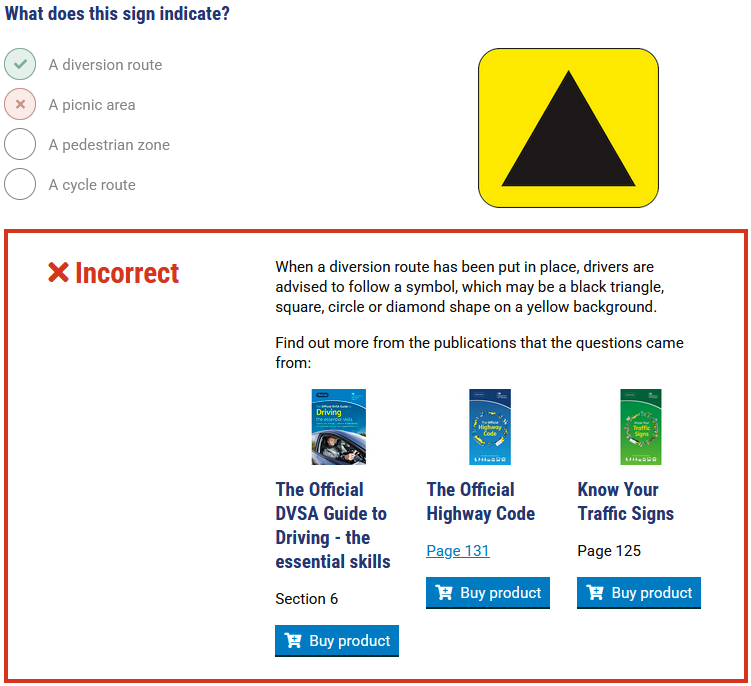
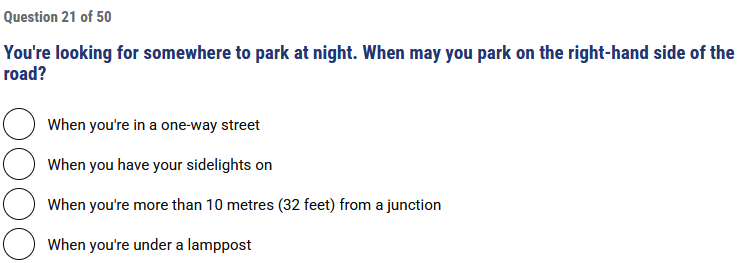
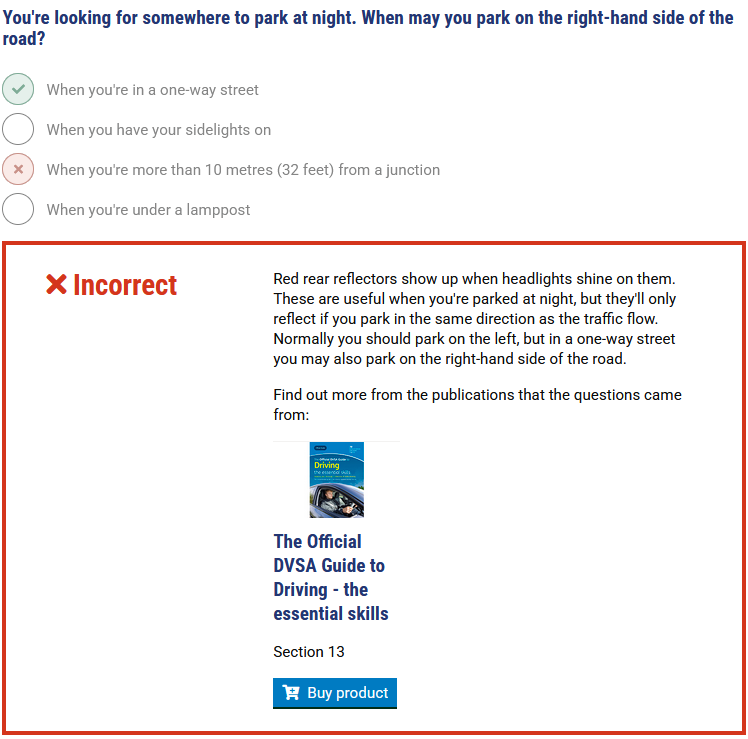
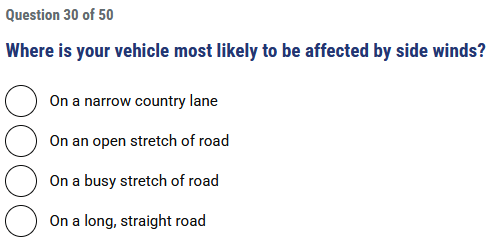
B
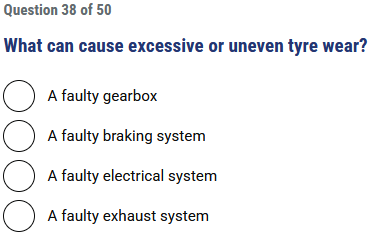
B
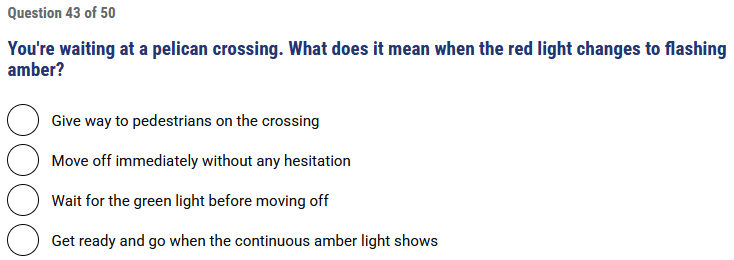
A
You're about to go down a steep hill. What should you do to control the speed of your vehicle?
- Answer: D. Select a low gear and use the brakes carefully.
- Explanation: When driving down a steep hill, gravity will cause your vehicle to speed up. This will make it more difficult for you to stop. To help keep your vehicle's speed under control, select a lower gear to give you more engine braking and make careful use of the brakes.
Which type of crossing allows cyclists to ride across with pedestrians?
Toucan
When must you use dipped headlights during the day?
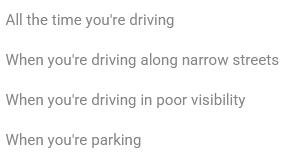
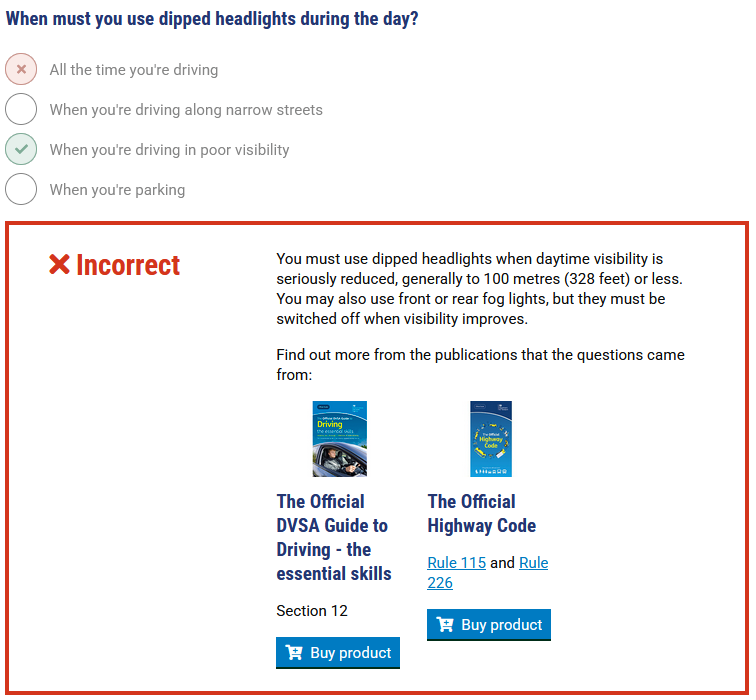
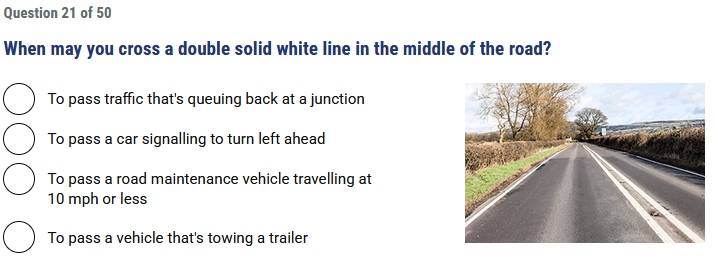
C
Why is it particularly important to check your vehicle before making a long motorway journey?
- Answer: A. Explanation:
- Explanation: Continuous high speeds increase the risk of your vehicle breaking down. Before you start your journey, make sure that your vehicle can cope with the demands of high-speed driving. You should check a number of things, the main ones being fuel, oil, water, and tires. You also need to plan rest stops if you're making a long journey.
When would you use the right hand lane on a threelane motorway?
- Answer: B. When you're overtaking,
- Explanation: carrying heavy loads will affect control and the vehicle's handling characteristics. If the vehicle you're driving is overloaded, you'll be held responsible.
When could the cost of your insurance be reduced?
- Answer: A. When you complete the Pass Plus scheme,
- Explanation: the cost of insurance varies with your age and how long you've been driving. Usually, the younger you are, the more expensive it is, especially if you're under 25. Pass Plus provides additional training to newly qualified drivers. The scheme is recognized by many insurance companies and taking this extra training could give you reduced insurance premiums as well as improving your skills and experience.
What does the term blind spot mean?
- Answer: D. An area not visible to the driver.
- Explanation: Modern vehicles provide the driver with a good view of both the road ahead and behind using wellpositioned mirrors. However, the mirrors can't see every angle of the scene behind and to the sides of the vehicle. It's essential that you know when and how to check the vehicle's blind spots so that you're aware of any hidden hazards.
When should you leave a 2-second gap between your vehicle and the one in front?
- Answer: A. When it's dry,
- Explanation: in good dry conditions, a driver needs to keep a distance of at least 2 seconds from the car in front. This should allow enough space for you to stop if the driver in front has to stop suddenly.
How can you use Use your vehicle's engine as a brake.
- Answer: B. By changing to a lower gear
- Explanation: when driving on downhill stretches of road, selecting a lower gear gives increased engine braking. This will prevent excessive use of the brakes which become less effective. if they overheat.
In order to supervise a learner driver, you need to have held a full driving license for the same category of vehicle for at least 3 years. What other requirement must you meet?
- Answer: B. to be at least 21 years old.
- Explanation: Learner drivers benefit by combining professional driving lessons with private practice. However, you need to be at least 21 years old and have held your driving license for at least 3 years before you can supervise a learner driver.
What's the legal minimum insurance cover you must have to drive on public roads?
- Answer: C. Third party only.
- Explanation: The minimum insurance required by law is third party cover. This covers your liability to others involved in a collision but not damage to your vehicle. Basic third-p partyy insurance also won't cover theft or fire damage. Ask your insurance company for advice on the best cover for you and make sure that you read the policy carefully.
What should you do if your vehicle catches fire while you're driving through a tunnel?
- Answer: A. drive it out of the tunnel if it safe to do so.
- Explanation: If it's possible, and you can do so without causing further danger, it may be safer to drive a vehicle that's on fire out of a tunnel. The greatest danger in a tunnel fire is smoke and suffocation.
What style of driving causes increased risk to everyone?
- Answer: A. Competitive.
- Explanation: Competitive driving increases the risks to everyone and is the opposite of responsible, considerate, and defensive driving. Defensive driving is about questioning the actions of other road users and being prepared for the unexpected. Don't be taken by surprise.
You're waiting to emerge at a junction. Your view is restricted by parked vehicles. What can help you to see traffic on the road you're joining?
- Answer: D. Reflections of traffic and windows.
- Explanation: You must be completely sure it's safe to emerge. merge. Try to look for traffic through the windows of the parked cars or in the reflections in windows. Keep looking in all directions as you slowly edge forwards until you can see it's safe.
You want to put a rear-facing baby seat on the front passenger seat. What must you do if the passenger seat is protected by a frontal airbag?
- Answer: B. Deactivate the airbag.
- Explanation: It's illegal to fit a rear-facing baby seat into a passenger seat protected by an active frontal airbag. If the airbag activates, it could cause serious injury or even death to the child. You must secure it in a different seat or deactivate the relevant airbag. Follow the manufactur 's advice when fitting a baby seat.
Which sign means that there may be people walking along the road?
Answer: D. Always check the road signs.
Explanation: Triangular signs are warning signs. They inform you about hazards ahead and help you to anticipate any problems. There are a number of different signs showing pedestrians. Learn the meaning of each one.
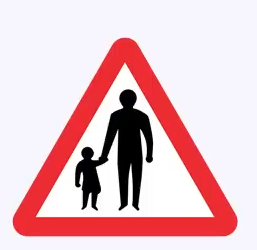
What does this sign mean?
- Answer: D. Route for trams.
- Explanation: Take extra Prepare when you encounter trams. Look out for road markings and signs that alert you to them. Modern trams are very quiet and you may not hear them approaching.
What does this sign mean?
- Answer: D. Two-way traffic.
- Explanation: It will take up to 10 times longer to stop when it's icy. Where there's a risk of icy conditions, you need to be aware of this and take extra care. If you think the road may be icy, don't break or steer harshly as your tires could lose their grip on the road.
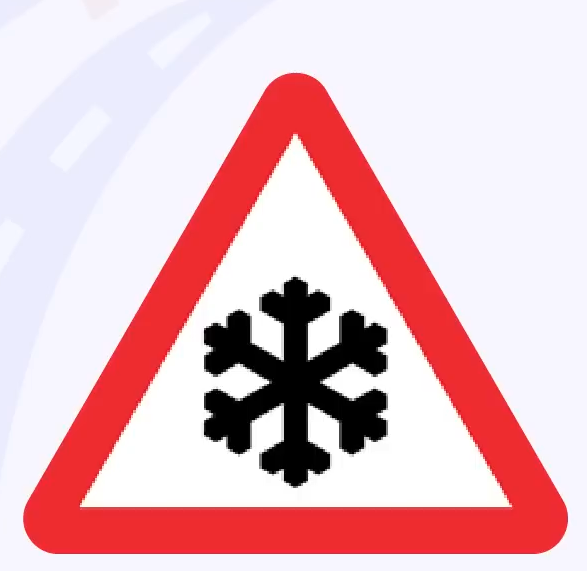
What does this sign mean?
Answer: B. Risk of ice
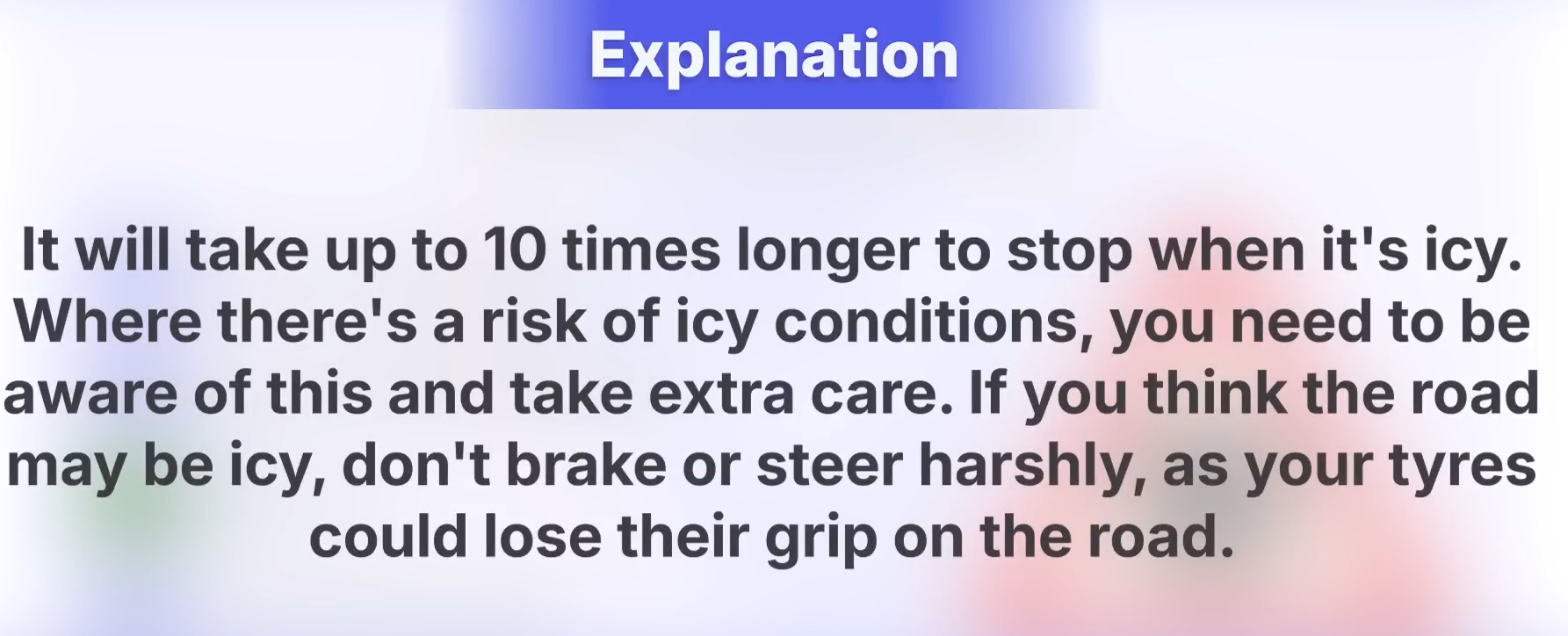

What does this sign mean?
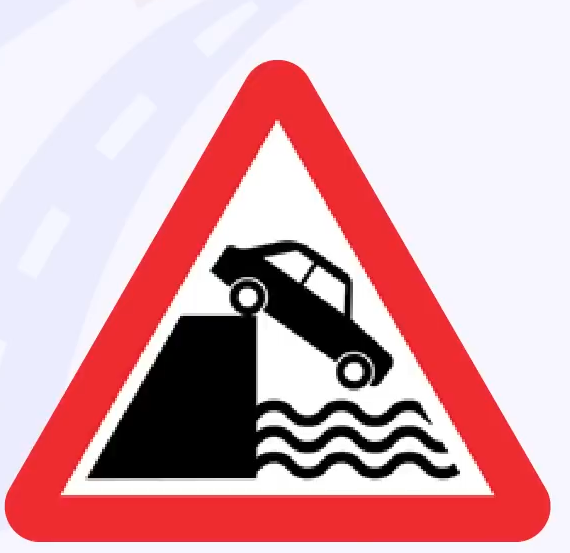
Answer: A. keyside or riverbank.
Explanation: You should be careful in these locations as the road surface is likely to be wet and slippery. There may be a steep drop to the water and there may not be a barrier along the edge of the road.
Which sign shows that you're entering a one-way system?
- Answer: B. Explanation:
- Explanation: If the road has two lanes, you can use either lane and overtake on either side. Use the lane that's more convenient for your destination, unless signs or road markings indicate otherwise.
What does this sign mean?
- Answer: D with flow bus and cycle lane.
- Explanation: Buses and cycles can travel in this lane. In this example, they'll flow in the same direction as other traffic. If it's busy, they may be passing you on the left, so watch out for them. Times on the sign will show the lane's hours of operation. If no times are shown or there's no sign at all, This means the lane is in operation 24 hours a day. In some areas, other vehicles such as taxis and motorcycles are allowed to use bus lanes. The sign will show if this is the case.
What does the solid white line at the side of the road indicate?
- Answer: B. Edge of the carriageway.
- Explanation: The continuous white line shows the edge of the carriageway. It can be especially useful when visibility is restricted, such as at night or in bad weather. It's discontinued in some places, for example, at junctions, laybys, entrances, or other openings.
Which in Instrument panel warning light would show that headlights are on main beam.
Answer: A. Explanation:
Explanation: You should be aware of all the warning lights and visual aids on the vehicle you're driving. If you're driving a vehicle for the first time, you should familiarize yourself with all the controls. warning lights and visual aids before you set off.
What's the main hazard shown in this picture?
Answer: B. The cyclist crossing the road.
Explanation: Look at the picture carefully and try to imagine you're there. The cyclist in this picture appears to be trying to cross the road. You must be able to deal with the unexpected, especially when you're approaching a hazardous junction. Look well ahead to give yourself time to deal with any hazards.
what should you do if a driver pulls out of a side road in front of you, causing you to break hard?
Answer: B. Ignore the error and stay calm.
Explanation: Be tolerant if a vehicle emerges and you have to break quickly. Anyone can make a mistake, so don't react aggressively. Be alert where there are side roads and be especially careful where there are parked vehicles because these can make it difficult for emerging drivers to see you.
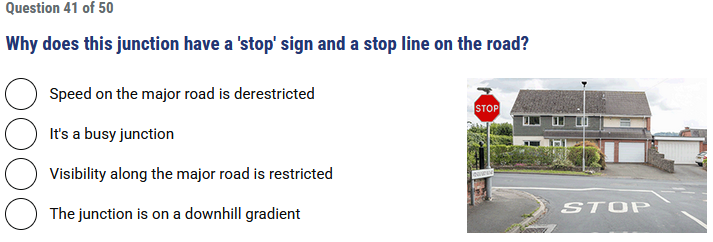
C

B
What is the sign for a ring road?
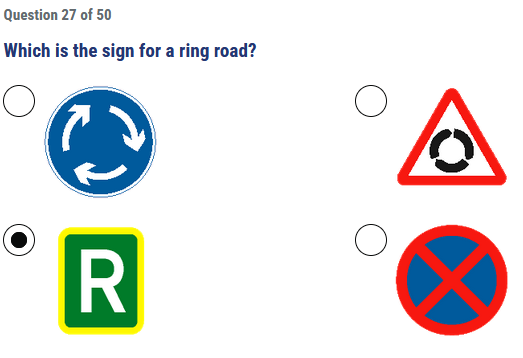
What color are the reflective studs between the hard shoulder and the left-hand lane of a motorway?
Answer: C. Red.
Explanation: Red studs are placed between the edge of the carriageway and the hard shoulder where slip roads lead. or join the motorway, the studs are green.
You're on a three-lane motorway. Which lane are you in if there are red reflective studs on your left and white ones to your right?
Answer: A. in the left hand lane.
Explanation: The colors of the reflective studs on the motorway and their locations are red between the hard shoulder and the carriageway, white between lanes, amber between the carriageway and the central reservation, green along slip road exits and entrances. Bright green or yellow at road works and contraflow systems.

C

D
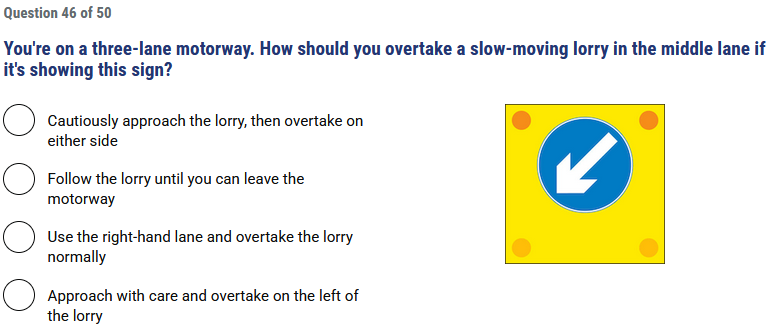
D
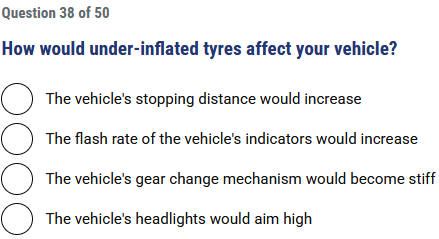
A
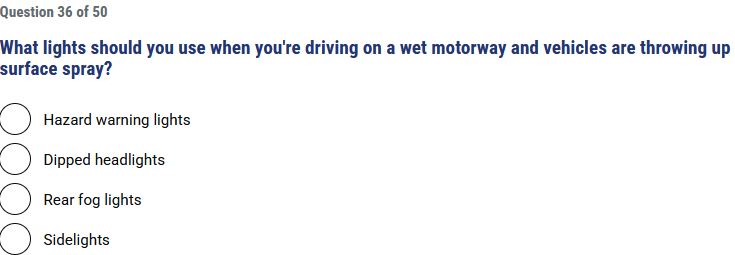
B
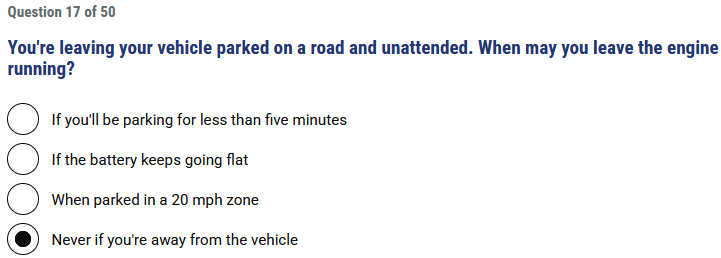
D

C
You stop on the the hard shoulder of a motorway and use the emergency telephone. Where's the best place to wait for help to arrive?
- Answer: C. Well away from the carriageway.
- Explanation: When you're on the hard shoulder, you're at risk of being injured by motorway traffic. The safest place to The weight is away from the carriageway but near enough to see the emergency services arriving.
3 basic hand signals?

A casualty isn't breathing normally and needs CPR. At what rate should you press down and release on the center of their chest?
- Answer: B. 120 times per minute.
- Explanation: If a casualty isn't breathing normally, cardopulmonary resuscitation, CPR, may be needed to maintain circulation. Place two hands on the center of the chest and press down hard and fast. around 5 to 6 cm and about twice a second.
When must your vehicle have valid insurance cover?
- Answer: D. Explanation:
- Explanation: Before you can tax the vehicle, your vehicle must have valid insurance cover before you can tax tax it if required. It will also need to have a valid MOT certificate. You can tax your vehicle online, by phone, or at certain post offices.
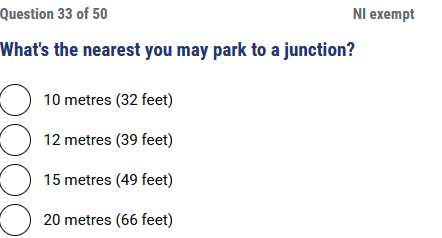
10m or 32 feet
How should you signal if you're going straight ahead at a roundabout?
- Answer: B. Signal left just after you pass the exit before the one you're going to take.
- Explanation: To go straight ahead at a roundabout, you should normally approach in the left-h hand lane, but check the road markings. At some roundabouts, the left lane on approach is marked left turn only. So, make sure you use the correct lane to go ahead. You won't normally need to signal as you approach, but signal before you leave the roundabout as other road users need to know your intentions.
A police officer asks to see your documents. You don't have them with you. How many days do you have to produce them at a police station? in
- Answer: D. 7 days.
- Explanation: You don't have to carry your vehicle's documents wherever you go. If a police officer asks to see them and you don't have them with you, you may be asked to produce them at a police station within 7 days.
An adult casualty isn't breathing. To maintain circulation, CPR should be given. What's the correct depth to press down on their chest?
- Answer: D. 5 to 6 cm.
- Explanation: An adult casualty isn't breathing normally. To maintain circulation, place two hands on the center of the chest. Then press down hard and fast around 5 to 6 cm and about twice a second.
What could cause you to crash if the level is allowed to get too low?
- Answer: C. Brake fluid level.
- Explanation: You should carry out frequent checks on all fluid levels, but particularly brake fluid. As the brake pads or shoes wear down, the brake fluid level will drop. If it drops below the minimum mark on the fluid reservoir, air could enter the hydraulic system and lead to a loss of braking efficiency or even complete brake failure.
You're following other vehicles in fog. You have your headlights on dipped beam. What else can you do to reduce the chances of being in a collision?
- Answer: A. Keep a safe distance from the vehicle in front.
- Explanation: When it's foggy, use your headlights on dipped beam. This will help you see and be seen by other road users. If visibility is seriously reduced, consider using front and rear fog lights if you have them. Keep to a sensible speed and don't follow the vehicle in front too closely. If the road is wet and slippery, you'll need to allow twice the normal stopping distance.
A collision has just happened. An injured person is lying in a busy road. What's the first thing you should do?
Answer: D. Warn other traffic.
Explanation: The most immediate danger is further collisions and fire. You could warn other traffic by switching on hazard warning lights, displaying an advanced warning triangle or sign, but not on a motorway or by any other means that doesn't put you or others at risk.
What do the white diagonal stripe markings in the middle of the road mean?
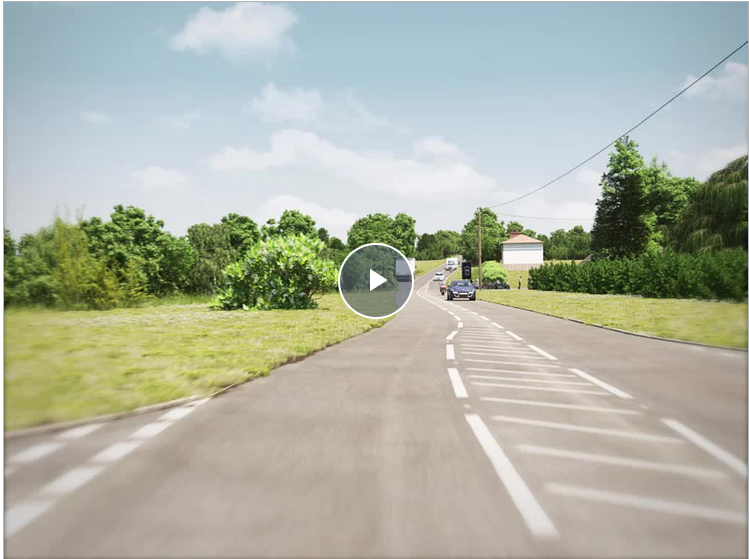
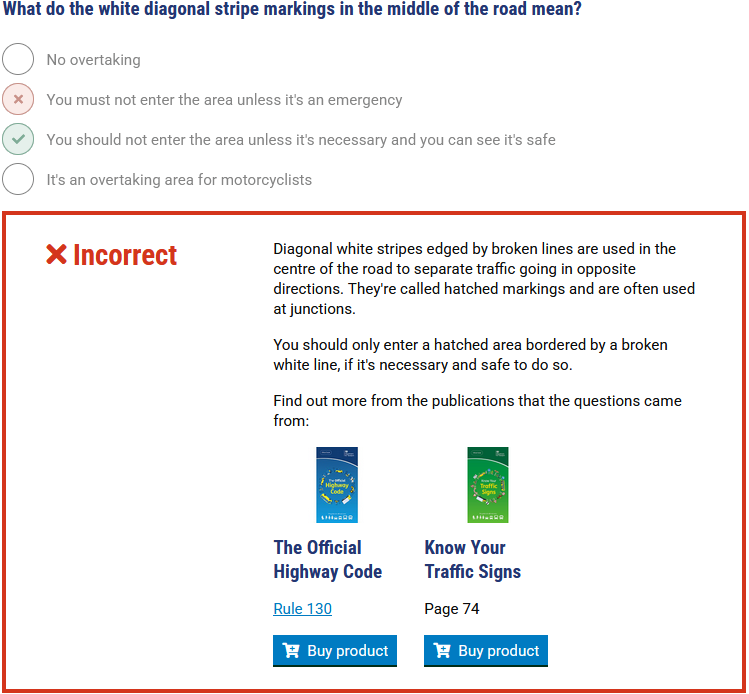
You're driving towards this level crossing. What would be the first warning of an approaching train?
Answer: A. A steady amber light.
Explanation: The steady amber light will be followed by twin flashing red lights that mean you must stop. An alarm will also sound to alert you to the fact that a train is approaching.
Why is it dangerous to overtake near a junction?
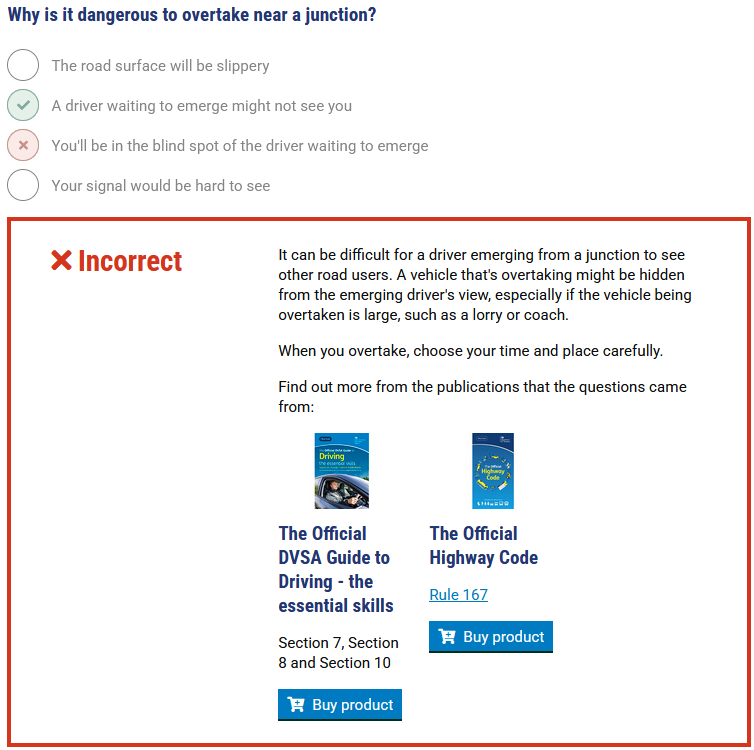
When are you allowed to wait on the yellow grid markings?
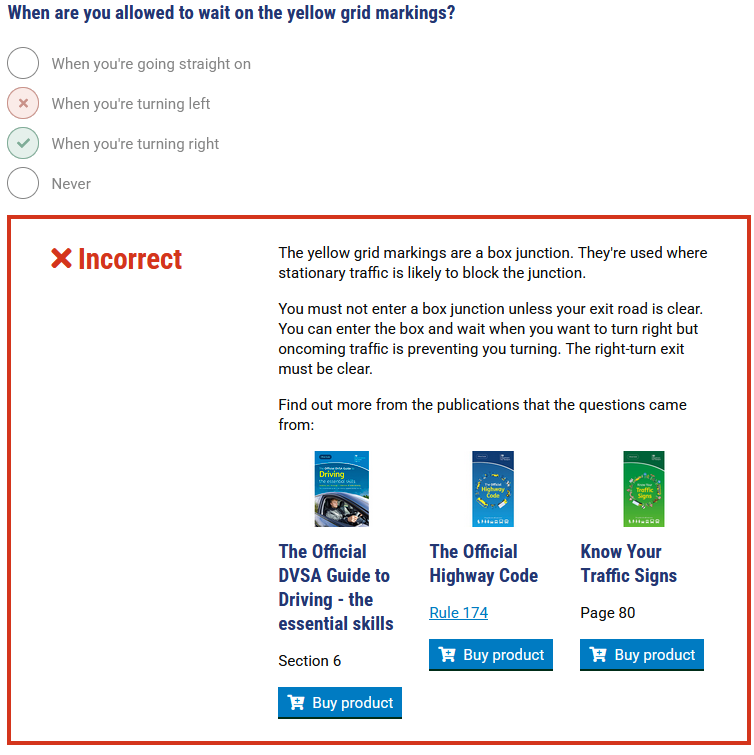
What does this sign mean?
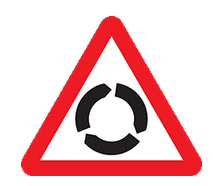

How can you reduce the damage your vehicle causes to the environment?
Answer: A. anticipate well ahead
Explanation: by Looking well ahead and recognizing hazards in good time. You can avoid late and heavy braking. Watch the traffic flow and look well ahead for potential hazards so you can control your speed in good time. Avoid overreving the engine and accelerating harshly as this increases wear to the engine and uses more fuel.
You're approaching traffic lights and the red light is showing. What signal will show next?
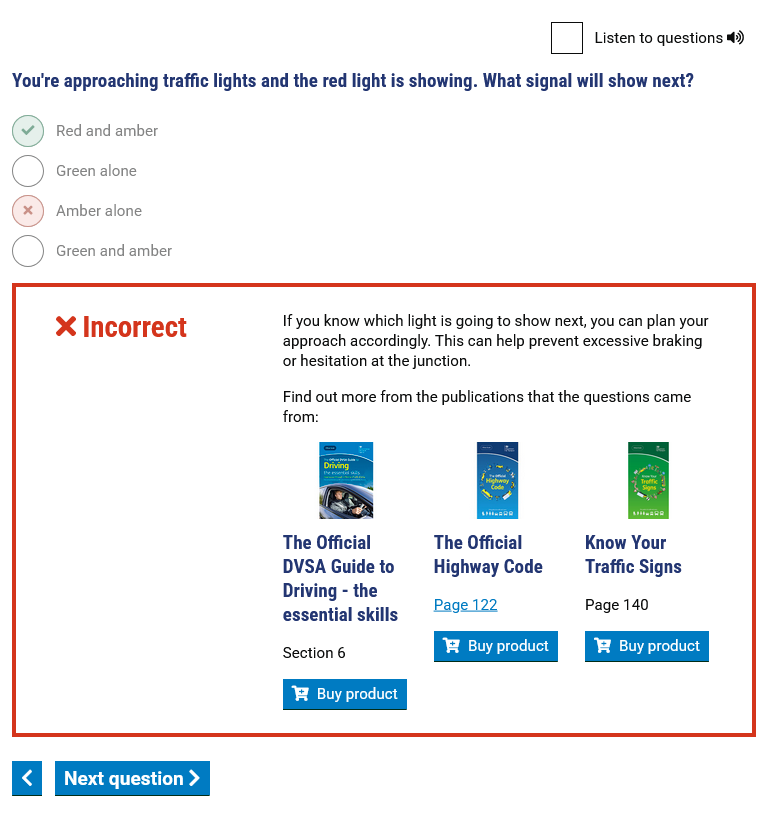
What should you do when you're approaching traffic lights that have red and amber showing together?
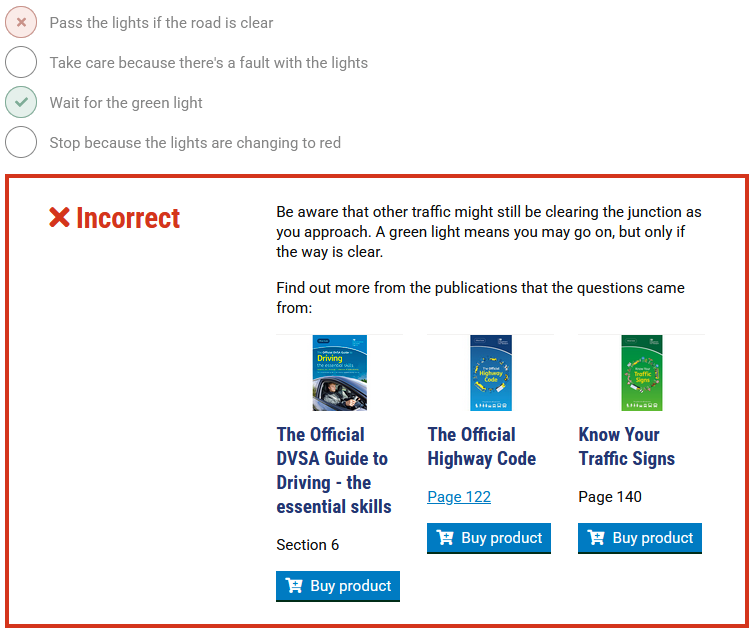
You're going to turn left from a main road into a minor road. What should you do as you approach the junction?
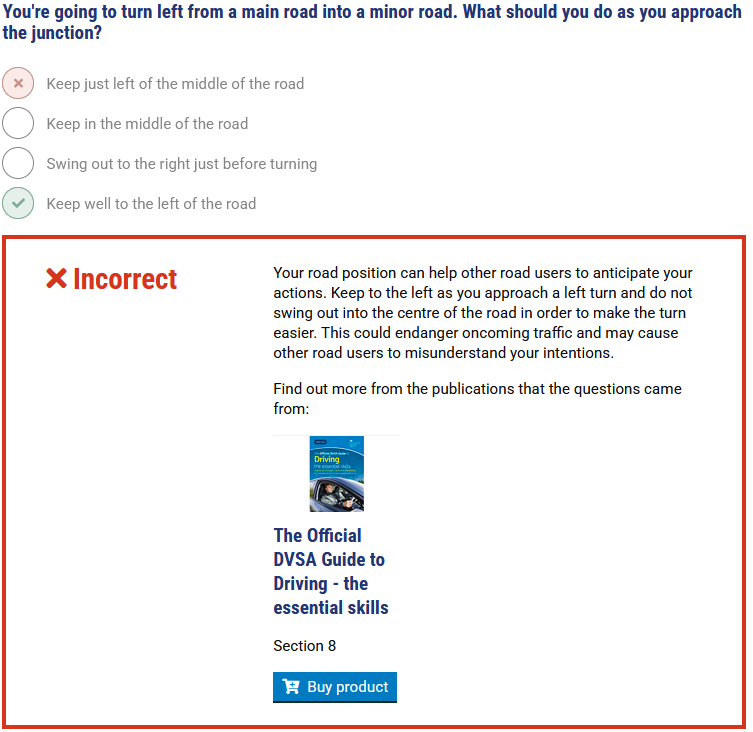
When may a passenger travel in a car? without wearing a seat belt.
- Answer: A. when they're exempt for medical reasons.
- Explanation: If you have adult passengers, it's their responsibility to wear a seat belt, but you should still remind them to use one as they get in the car. It's your responsibility to make sure that all children in your car are secured with an appropriate restraint. Exemptions are allowed for those with a medical exemption certificate.
You're driving towards a zebra crossing. What should you do if a person in a wheelchair is waiting to cross?

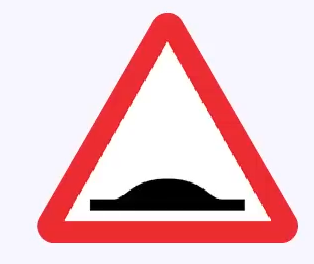
Which plate may appear with this road sign?
Answer: A. Explanation:
Explanation: Road humps are used to slow down traffic. They're found in places where there are often pedestrians, such as shopping areas, near schools, residential areas. Watch out for people close to the curb or crossing the road.
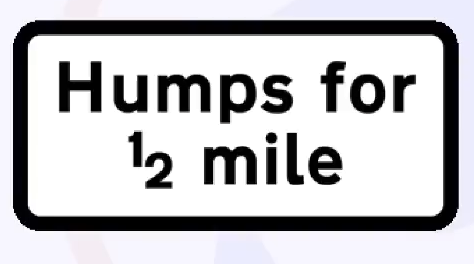
You're traveling along a motorway. Where would you find a crawler or climbing lane?
Answer: D. On a steep gradient,
Explanation: large slowmoving vehicles can hinder the progress of other traffic. On a steep gradient, an extra crawler lane may be provided for slowmoving vehicles to allow faster moving traffic to flow more easily.
What does this sign mean?
Answer: B. No right turn.
Explanation: The no right turn sign may be used to warn road users that there's a No entry prohibition on a road to the right ahead.
You're about to overtake. What should you do when you see this sign?
Answer: A. Hold back until you can see clearly ahead.
Explanation: You won't be able to see any hazards that might be hidden in the dip as well as oncoming traffic. The dip may conceal cyclists, horse riders, parked vehicles, pedestrians in the road.
What do these zigzag white lines mean?
Answer: A. no park. at any time.
Explanation: The approach to and exit from a pedestrian crossing is marked with zigzag lines. You mustn't park on them or overtake the leading vehicle when approaching the crossing. Parking here would block the view for pedestrians and approaching traffic.
What does this motorway sign mean?
Answer: C. Temporary maximum speed 50 mph.
Explanation: Look out for signs above your lane or on the central reservation. These will give you important information or
What does this sign indicate?
Answer: B. a diversion route.
Explanation: When a diversion route has been put in place, drivers are advised to follow a symbol which may be a black triangle, square, circle, or diamond shape on a yellow background.
You're in the right hand lane of a three-lane motorway. What do these overhead signs mean?
Answer: B. Move to the left and reduce your speed to 50 m hour.
Explanation: You must obey these signs even if there appear to be no problems ahead. There could be queuing traffic or another hazard that you can't see yet.
What does this sign mean?
Answer: C. Mini roundabout.
Explanation: When you see this sign, look out for any direction signs and judge whether you need to signal your intentions.
What does this signal from a police officer mean to oncoming traffic.
Answer: B. Stop.
Explanation: Police officers may need to direct traffic, for example, at a junction where the traffic lights have broken down. Check your copy of the highway code for the signals that they use.
You're driving on a road with several lanes. What do these signs above the lanes mean?
- Answer: A. The two left lanes are open.
- Explanation: On some busy roads, lane control signals are used to vary the number of lanes available to give priority to the main traffic. flow. A green arrow indicates that the lane is available to traffic facing the signal. A white diagonal arrow means that the lane is closed ahead and traffic should move to the next lane on the left. A red cross means that the lane is closed to traffic facing the signal.
You're waiting at a level crossing. What should you do if the red warning lights continue to flash after a train has passed by?
- Answer: A. Continue to wait.
- Explanation: At a level crossing, flashing red lights mean you must stop. If the train passes but the lights keep flashing, wait. Another train may be coming.
How should you give an arm signal to turn left?
- Answer: C. Explanation:
- Explanation: There may be occasions when other road users are unable to see your indicator, such as in bright sunlight or at a busy complicated junction. In these cases, an arm signal will help others to understand your intentions.
What does it mean if the electronic stability control ESC indicator lamp lights up while you're driving?
- Answer: B. The ESC system has activated.
- Explanation: ESC is a computer controlled technology that detects reduced traction and automatically makes corrective adjustments to prevent loss of control. The ESC lamp comes on to alert the driver that the system has activated and the car is approaching its handling limits. It's a powerful driver aid, but it cannot save a car once its traction limits have been exceeded.